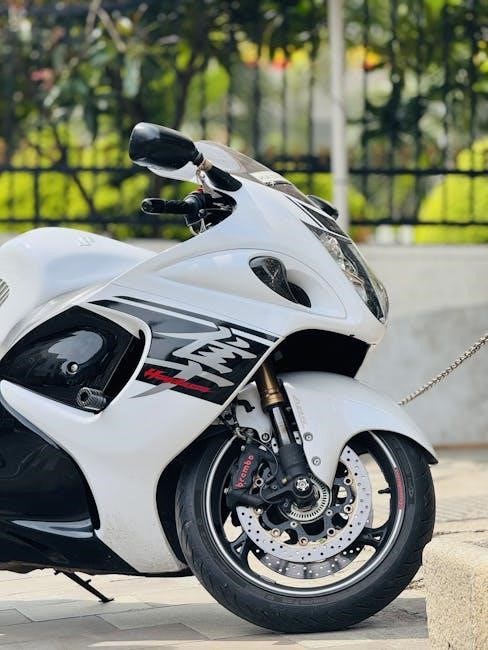The Cleveland Wheels and Brakes Manual is a comprehensive guide for maintaining and overhauling aircraft wheel and brake systems. It covers inspection, installation, and troubleshooting procedures, ensuring compliance with safety standards and regulatory requirements for general aviation aircraft. Adherence to this manual is crucial for optimal performance and warranty validity.
1.1 Overview of Cleveland Wheel & Brake Systems
Cleveland Wheel & Brake Systems provide high-quality, durable solutions for general aviation aircraft. Their products include wheels, brake assemblies, and cylinders, designed to meet rigorous safety and performance standards. The systems are constructed from lightweight, corrosion-resistant materials like aluminum alloys and steel, ensuring reliability and longevity. Brake assemblies feature components such as linings, pistons, and back plates, while wheels are equipped with bearings and covers for smooth operation. Cleveland’s designs emphasize minimal weight and efficient heat dissipation, critical for optimal braking performance. These systems are widely used in various aircraft due to their proven track record of reliability and compliance with regulatory requirements. Proper maintenance, as outlined in the manual, ensures continued safety and efficiency.
1.2 Purpose of the Manual
The purpose of the Cleveland Wheels and Brakes Manual is to provide detailed guidance for the maintenance, inspection, and overhaul of Cleveland wheel and brake systems. It serves as a primary reference for technicians and maintenance personnel, ensuring compliance with safety standards and regulatory requirements; The manual outlines procedures for proper installation, troubleshooting, and repair, as well as torque specifications and dimensional tolerances. It emphasizes adherence to approved part numbers and compatibility with specific aircraft models. By following the manual, users can ensure optimal performance, safety, and longevity of the wheel and brake components. Proper use of this manual is essential to maintain warranty validity and operational integrity of the aircraft.
1.3 Scope of the Document
The Cleveland Wheels and Brakes Manual encompasses a wide range of topics essential for the proper maintenance and operation of Cleveland wheel and brake systems. It includes detailed procedures for inspection, installation, and overhaul, as well as troubleshooting common issues. The document provides specific torque specifications for brake disc bolts and guidance on brake assembly installation. Additionally, it covers material standards, dimensional tolerances, and compatibility with general aviation aircraft. The manual also references the Cleveland Product Catalog for assembly numbers and approved part numbers. By adhering to the manual, users ensure compliance with safety and regulatory standards, maintaining the integrity and performance of the wheel and brake systems; This comprehensive scope ensures all aspects of maintenance are addressed effectively.
Key Components of the Manual
The manual includes the Component Maintenance Manual (CMM), Aircraft Maintenance Manual (AMM) references, and Product Catalog, providing detailed procedures, part numbers, and technical specifications for Cleveland wheels and brakes.
2.1 Component Maintenance Manual (CMM)
The Component Maintenance Manual (CMM) provides detailed instructions for the maintenance and overhaul of Cleveland wheels and brakes. It includes troubleshooting guides, on-aircraft and off-aircraft procedures, and specific torque specifications for brake disc bolts. The CMM is essential for ensuring compliance with safety standards and maintaining the integrity of the brake system. Regular reference to this manual is crucial for technicians to perform accurate and efficient maintenance tasks. Additionally, the CMM covers the replacement of worn or damaged components, such as brake cylinders and linings, and outlines the proper tools and techniques required for each procedure. Adherence to the CMM ensures optimal performance and longevity of the aircraft’s braking system.
2.2 Aircraft Maintenance Manual (AMM) References
The Aircraft Maintenance Manual (AMM) is a critical resource for technicians working with Cleveland wheels and brakes. It provides specific instructions for the installation, inspection, and maintenance of these components on various aircraft models. The AMM should be consulted alongside the Component Maintenance Manual (CMM) to ensure compliance with manufacturer guidelines. It contains detailed part numbers, torque specifications, and procedural steps tailored to individual aircraft configurations. Additionally, the AMM includes references to optional installations and airframe log book entries, which are essential for verifying compatibility and ensuring proper documentation. By cross-referencing the AMM with the CMM, technicians can maintain compliance with safety and regulatory standards, ensuring reliable performance of Cleveland wheels and brakes. Any inconsistencies found should be reported to Cleveland Customer Support for clarification. This collaborative approach guarantees accurate and efficient maintenance practices.
2.3 Product Catalog References
The Cleveland Wheels and Brakes Product Catalog is an essential resource for identifying and selecting the correct components for specific aircraft applications. It provides detailed listings of wheel and brake assembly numbers, cylinder assembly details, and approved part numbers. Technicians can use the catalog to cross-reference components, ensuring compatibility and compliance with manufacturer specifications. The catalog also includes dimensional tolerances, material standards, and surface finish requirements for wheels and brakes. By referencing the product catalog, users can locate the appropriate section and page number for their specific needs. This ensures accurate ordering and installation of Cleveland wheels and brakes, maintaining safety and performance. Regular updates to the catalog reflect the latest product developments and regulatory requirements. Always consult the catalog alongside the Component Maintenance Manual (CMM) for comprehensive maintenance guidance.

Maintenance and Overhaul Procedures
Maintenance and overhaul procedures for Cleveland wheels and brakes include detailed inspection, torque specifications, brake assembly installation, and troubleshooting common issues to ensure optimal performance and safety.

3.1 Inspection Procedures for Wheels and Brakes
Inspection of Cleveland wheels and brakes involves checking for wear, damage, or corrosion. Brake linings should be inspected for minimum thickness, and discs must be measured for thickness and checked for excessive run-out; Wheel bearings are examined for smooth operation, and the brake cylinder surface should be free from deep depressions. Any component showing excessive wear or damage must be replaced. Regular inspections ensure compliance with safety standards and prevent potential failures. Always refer to the Component Maintenance Manual for detailed procedures and specifications to maintain the integrity of the wheel and brake system.
3.2 Torque Specifications for Brake Disc Bolts
Torque specifications for Cleveland brake disc bolts are critical for ensuring proper installation and safety. The recommended dry torque for brake disc bolts is 150 in-lbs. However, torque values may vary depending on the specific hardware configuration. Refer to PRM 83 for detailed torque specifications, as values are subject to change with hardware upgrades. Always consult the Component Maintenance Manual (CMM) for the most accurate and up-to-date information. Proper torque ensures even pressure distribution, preventing brake disc warping or bolt failure. Incorrect torque can lead to safety hazards, so adherence to specified values is essential. For interim guidance, follow the torque values provided on the wheel assembly nameplate until updated PRMs are released.

3.3 Brake Assembly Installation Guidance
Proper installation of Cleveland brake assemblies is essential for safe and reliable operation. Always refer to the Component Maintenance Manual (CMM) for detailed procedures. Ensure the brake assembly is correctly aligned with the wheel and axle before installation. Secure the assembly using approved hardware, following torque specifications outlined in the manual. Use only Cleveland-approved components to maintain warranty validity and system performance. Improper installation or use of non-approved parts can lead to brake failure and void the warranty. Follow all safety precautions and guidelines to ensure the assembly is properly seated and functioning as intended. Correct installation is critical for optimal braking performance and aircraft safety.
3.4 Troubleshooting Common Issues
Troubleshooting Cleveland wheel and brake systems requires careful analysis of symptoms and adherence to the Component Maintenance Manual (CMM). Common issues include excessive brake wear, uneven braking, and fluid leaks. Inspect brake cylinders for depressions exceeding 0.005 inches, as they may require replacement. Verify torque values for brake disc bolts, ensuring they match specifications in the manual. Incorrect torque can lead to premature wear or failure. Always use approved parts, as non-Cleveland components can void the warranty and compromise safety. Refer to the CMM for diagnostic procedures and repair guidelines. Failure to follow proper troubleshooting steps may result in reduced braking performance or system failure. Regular maintenance and adherence to manual guidelines are critical for ensuring reliable operation and safety.
Cleveland Wheels and Brakes Product Catalog
The Cleveland Wheels and Brakes Product Catalog provides detailed assembly numbers, cylinder specifications, and approved part numbers for specific aircraft, ensuring compatibility and safety.
4.1 Wheel and Brake Assembly Numbers
The Cleveland Wheels and Brakes Product Catalog lists specific wheel and brake assembly numbers for various aircraft applications. These numbers are crucial for identifying the correct components for installation or maintenance. Users can find the applicable assembly numbers by referencing the table of contents, which directs them to the appropriate section and page. The catalog ensures compatibility by providing detailed part information, helping technicians and mechanics select the right equipment for their aircraft. Proper use of these assembly numbers guarantees safety, performance, and compliance with regulatory standards. Always verify the assembly numbers with the Aircraft Maintenance Manual and Airframe Log Books to ensure accuracy and avoid warranty issues.

4.2 Cylinder Assembly Details

The cylinder assembly in Cleveland Wheels and Brakes systems includes a back plate, pressure plate, brake linings, piston(s), and other components. It is essential to refer to the Component Maintenance Manual (CMM) for detailed maintenance and overhaul procedures. The assembly must be inspected for wear or damage, with specific attention to surface depressions exceeding 0.005 inches, which require replacement. Torque values for hardware configurations are provided in the manual, ensuring proper installation and safety. Using components from other manufacturers voids the warranty. Always follow Cleveland’s guidelines for compatibility and performance, as outlined in the Product Catalog and technical documentation. Proper assembly maintenance is critical for reliable braking systems and aircraft safety.
4.3 Approved Part Numbers for Specific Aircraft
Approved part numbers for Cleveland Wheels and Brakes are aircraft-specific and must be confirmed by referencing the Aircraft Maintenance Manual (AMM) and Airframe Log Books. The Component Maintenance Manual (CMM) provides detailed procedures for verifying compatibility. Use the Cleveland Product Catalog to identify the correct wheel and brake assembly numbers for your aircraft. Ensure all components are genuine Cleveland parts, as using non-approved parts voids the warranty. Proper part selection ensures safety, performance, and compliance with regulatory standards. Always cross-reference part numbers with the latest documentation to avoid installation errors. This step is critical for maintaining aircraft airworthiness and ensuring reliable braking systems. Adherence to approved part numbers guarantees optimal functionality and longevity of the brake and wheel assemblies.

Technical Specifications and Requirements
Technical specifications for Cleveland Wheels and Brakes include material standards, dimensional tolerances, and surface finish requirements. These ensure compatibility, safety, and optimal performance in general aviation aircraft.
5.1 Material Standards for Wheels and Brakes
Cleveland Wheels and Brakes adhere to strict material standards to ensure durability and safety. Brake cylinders must meet specific surface finish requirements, with depressions exceeding 0.005 inches requiring replacement. Wheel assembly tie bolts and nuts are torqued to precise specifications, applied solely to the nut. These standards ensure compatibility with general aviation aircraft and compliance with regulatory demands. Material integrity is critical for optimal performance and longevity, guaranteeing reliable braking systems under various operating conditions.
5.2 Compatibility with General Aviation Aircraft
Cleveland Wheels and Brakes are specifically designed for compatibility with general aviation aircraft, ensuring seamless integration and optimal performance. The systems are tailored to meet the unique demands of various aircraft models, including single-engine, multi-engine, and other general aviation planes. The manual provides detailed guidelines for installation, maintenance, and overhaul procedures, ensuring compliance with aircraft-specific requirements. By adhering to the material standards and torque specifications outlined in the manual, technicians can ensure proper functionality and safety. This compatibility is a cornerstone of Cleveland Wheels and Brakes’ reputation for reliability and performance in the aviation industry.
5.3 Dimensional Tolerances and Surface Finish
The Cleveland Wheels and Brakes Manual specifies precise dimensional tolerances and surface finish requirements to ensure proper fitment and functionality of components. These standards are critical for maintaining safety, performance, and durability. The manual outlines acceptable tolerances for brake discs, cylinders, and wheel assemblies, ensuring minimal wear and optimal braking efficiency. Surface finish specifications are provided to prevent premature wear and corrosion, particularly in high-stress areas. Adherence to these guidelines is essential for maintaining warranty validity and ensuring compliance with regulatory standards. Proper torque values and hardware configurations are also emphasized to meet these tolerances, guaranteeing reliable operation across various general aviation aircraft applications.

Customer Support and Resources
Cleveland Wheels and Brakes offers dedicated customer support for inquiries, technical assistance, and warranty claims. Access detailed documentation, including manuals and product catalogs, for seamless maintenance and troubleshooting.
6.1 Contact Information for Cleveland Customer Support
For assistance with Cleveland Wheels and Brakes, contact their customer support team directly. The manual directs users to visit the official Cleveland Wheels and Brakes website for detailed contact information. Support options include phone, email, and online forms. Technical inquiries, warranty claims, and troubleshooting requests can be addressed through these channels. Ensure to reference the provided resources or the Component Maintenance Manual for specific guidance. Contacting Cleveland Customer Support is essential for resolving issues promptly and ensuring compliance with maintenance and safety standards.
6.2 Accessing Technical Documentation
Accessing Cleveland Wheels and Brakes technical documentation is straightforward. The Component Maintenance Manual (CMM) and product catalog are available on the official Cleveland Wheels and Brakes website. These resources provide detailed maintenance procedures, part numbers, and troubleshooting guides. Users can download PDF versions of the manuals, ensuring access to the latest updates and revisions. Additionally, the website offers a “Find by Aircraft” tool to identify specific documentation for your aircraft. For convenience, the manuals are organized by sections, allowing quick navigation to relevant information. Always reference the most recent versions to ensure compliance with safety and regulatory standards.
6.3 Warranty Information and Conditions
Cleveland Wheels and Brakes offers a comprehensive warranty program for their products. The warranty clause for wheel and brake assemblies is detailed in the manual, ensuring coverage under specific conditions. To maintain warranty validity, users must adhere to the guidelines outlined in the Component Maintenance Manual and use only approved Cleveland components. Any unauthorized modifications or the use of third-party parts will void the warranty. The warranty period and terms are specified in the manual, which is available on the Cleveland Wheels and Brakes website. Customers are encouraged to review the warranty section thoroughly to understand their rights and obligations. Proper compliance ensures optimal product performance and safety.
Installation and Safety Guidelines
Proper installation of Cleveland Wheels and Brakes requires adherence to torque specifications and safety precautions. Always follow the manual’s guidance to ensure system integrity and safety compliance.
7.1 Proper Installation of Brake Assemblies

Proper installation of Cleveland brake assemblies requires strict adherence to the Component Maintenance Manual (CMM) and Cleveland Wheels and Brakes Product Catalog. Ensure all components are inspected for damage or wear before installation. Torque brake disc bolts to specified values, noting that torque applies only to the nut. Refer to the CMM for detailed procedures and torque specifications. Use of non-approved parts or incorrect torque values may void the warranty. Always follow safety guidelines to prevent injury or system malfunction. Proper installation ensures optimal braking performance, safety, and compliance with regulatory standards. Consult Cleveland customer support for any installation-related queries or clarifications.
7.2 Safety Precautions During Maintenance
When performing maintenance on Cleveland Wheels and Brakes, adhere to strict safety precautions to ensure personal safety and system integrity. Always wear appropriate protective gear, including gloves and safety glasses. Ensure the aircraft is securely supported on jack stands and the parking brake is engaged. Never attempt maintenance without proper tools or training. Follow torque specifications precisely, as outlined in the Component Maintenance Manual (CMM). Avoid using unauthorized components, as this may compromise safety and void the warranty. Keep loose clothing and long hair tied back to prevent entanglement with moving parts. Refer to the Cleveland Wheels and Brakes Product Catalog for approved part numbers and installation guidelines. Always consult the CMM or contact Cleveland Customer Support for clarification on any procedure.
7.3 Compliance with Regulatory Standards
Compliance with regulatory standards is critical when working with Cleveland Wheels and Brakes. Ensure all maintenance and installation procedures align with aviation regulations and industry standards. Refer to the Component Maintenance Manual (CMM) for detailed guidelines on meeting these requirements. Use only approved part numbers, as specified in the Cleveland Wheels and Brakes Product Catalog, to maintain compliance. Proper documentation of all maintenance activities is essential for regulatory audits. Always follow safety protocols and inspection procedures outlined in the manual to avoid non-compliance issues. Failure to adhere to these standards may result in legal consequences, safety risks, or voidance of the product warranty. Regulatory compliance ensures the integrity and safety of the aircraft braking system. Adherence to these standards is non-negotiable for safe and reliable operation.
The Cleveland Wheels and Brakes Manual is essential for safe, efficient maintenance. Adherence to its guidelines ensures compliance, optimal performance, and warranty validity. Follow it meticulously.
8.1 Summary of Key Points
The Cleveland Wheels and Brakes Manual provides detailed guidance for maintenance, inspection, and overhaul of aircraft wheel and brake systems. It emphasizes adherence to specified procedures to ensure safety and optimal performance. The manual references the Component Maintenance Manual (CMM) and Aircraft Maintenance Manual (AMM) for detailed instructions. Proper torque specifications and installation procedures are highlighted to prevent issues. Use of non-Cleveland components voids the warranty; The manual also covers troubleshooting common problems and outlines approved part numbers for specific aircraft. Compliance with regulatory standards is stressed to maintain airworthiness. Following the manual ensures reliable operation and extends the lifespan of wheel and brake assemblies.

8.2 Importance of Adhering to Manual Guidelines
Adhering to the Cleveland Wheels and Brakes Manual guidelines is critical for ensuring the safety, reliability, and performance of aircraft wheel and brake systems. Proper maintenance and installation procedures prevent potential failures and extend component lifespan. Deviating from specified torque values or using non-approved parts can lead to system malfunctions and void warranties. Compliance with manual instructions ensures adherence to regulatory standards, maintaining airworthiness and operational safety. Technicians must follow detailed inspection, troubleshooting, and overhaul procedures to guarantee optimal functionality. By adhering to the manual, operators can minimize risks, reduce maintenance costs, and ensure the integrity of Cleveland Wheels and Brakes systems for reliable flight operations.
8.3 Final Thoughts on Cleveland Wheels and Brakes
Cleveland Wheels and Brakes stands as a trusted name in aviation, delivering high-quality components and comprehensive support. The manual serves as an essential resource for technicians, ensuring safe and efficient maintenance. By following its guidelines, operators can maintain optimal performance and extend the lifespan of their systems. Cleveland’s commitment to quality and customer support underscores its reputation as a leader in the industry. Whether for routine inspections or complex overhauls, the manual provides clear, actionable guidance. Adhering to its instructions not only ensures compliance with safety standards but also upholds the integrity of Cleveland’s products. This dedication to excellence makes Cleveland Wheels and Brakes a reliable choice for aircraft maintenance worldwide.